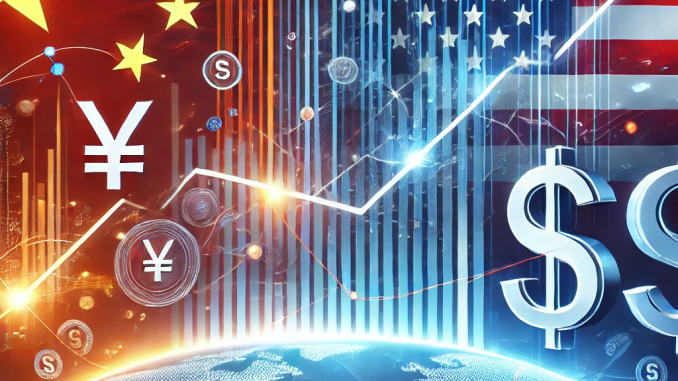
Introduction
The global financial landscape is undergoing a significant shift as two major economic forces—China and the United States—implement drastic policy changes. China is making aggressive efforts to revive its struggling stock market, while the US has introduced new tariffs that are expected to have ripple effects across emerging economies. These developments highlight the interconnected nature of global markets, where a policy shift in one country can trigger widespread economic consequences worldwide.
In this article, we will examine China’s strategies to rejuvenate its stock market, analyze the impact of US tariffs on emerging economies, and explore the broader implications for investors and financial markets.
China’s Efforts to Revive Its Stock Market
The Decline and Government Intervention
China’s stock market has been facing prolonged challenges, including declining investor confidence, a real estate crisis, and slowing economic growth. The Shanghai Composite Index and the Hang Seng Index in Hong Kong have both experienced substantial drops over the past year, leading to concerns about financial instability.
In response, the Chinese government has implemented several measures to stabilize the markets:
• State-Backed Buying: Reports indicate that China’s sovereign wealth funds and state-owned financial institutions have been directed to purchase large volumes of local stocks to prevent further declines.
• Tighter Regulations on Short Selling: Authorities have tightened regulations on short selling and other speculative activities to curb excessive volatility.
• Interest Rate Cuts and Liquidity Injection: The People’s Bank of China (PBOC) has cut interest rates and injected liquidity into the financial system to stimulate growth and encourage investment.
• Easing Property Sector Restrictions: Since the real estate sector is a key component of China’s economy, the government has relaxed lending rules for property developers and homebuyers to boost confidence.
Will These Measures Work?
While these policies may provide short-term relief, analysts remain skeptical about their long-term effectiveness. China’s economy still faces structural issues, including high debt levels and weak consumer demand. Unless broader economic reforms are implemented, stock market intervention alone may not be enough to sustain long-term growth.
US Tariffs and Their Impact on Emerging Economies
New Tariff Policies and Rationale
In contrast to China’s stimulus efforts, the United States has taken a more aggressive stance on trade, recently announcing new tariffs on imports from emerging economies, particularly in Asia. The tariffs target industries such as technology, semiconductors, and manufacturing, aiming to protect domestic industries and reduce dependency on foreign supply chains.
The Biden administration justifies these measures as part of a broader strategy to strengthen the US economy and national security. However, these policies are likely to have significant consequences for emerging markets that rely on exports to the US.
Emerging Economies at Risk
Several Asian economies, including Vietnam, Indonesia, Malaysia, and India, have built their economic growth models around exports, particularly in the technology and manufacturing sectors. With higher tariffs, these countries could face:
• Declining Export Revenues: Higher tariffs mean higher costs for US consumers and businesses purchasing goods from these nations, which could reduce demand for their exports.
• Supply Chain Disruptions: Many companies that manufacture components in multiple countries before assembling the final product in the US could see disruptions due to increased trade barriers.
• Investor Uncertainty: The tariffs could lead to reduced foreign direct investment (FDI) in emerging markets, as investors may shift capital to regions with more stable trade policies.
A Lose-Lose Situation?
While the US aims to protect its industries, the tariffs could have unintended consequences. By increasing production costs for American companies that rely on imported materials, inflationary pressures may rise, ultimately hurting consumers. Meanwhile, emerging economies may seek alternative markets, leading to potential shifts in global trade alliances.
Broader Implications for Investors and Financial Markets
Short-Term Volatility
The combination of China’s market intervention and US trade restrictions is expected to create volatility in global financial markets. Investors should brace for fluctuations in stock prices, particularly in Asian markets, as uncertainty remains high.
Opportunities in Alternative Markets
As China attempts to stabilize its markets and the US increases trade barriers, investors may start exploring opportunities in alternative markets, such as:
• Latin America and Africa: These regions could benefit from shifting trade relationships as emerging economies look for new markets.
• Sectors Less Affected by Trade Disputes: Industries such as healthcare, renewable energy, and AI-driven technology may offer more stability amid trade tensions.
• Safe-Haven Assets: Given market uncertainty, assets like gold, US Treasuries, and cryptocurrencies may see increased demand.
Strategic Moves for Investors
For those navigating this evolving financial landscape, the following strategies may be worth considering:
1. Diversification: Investing across different asset classes and geographic regions can help mitigate risks associated with market volatility.
2. Monitoring Policy Developments: Keeping a close eye on regulatory changes and government policies will be crucial for making informed investment decisions.
3. Long-Term Perspective: While short-term fluctuations are inevitable, focusing on long-term growth opportunities can lead to more sustainable investment success.
The ongoing shifts in global markets, driven by China’s stock market interventions and US tariff policies, highlight the complex interplay of economic forces shaping the financial world. While China’s stimulus measures may provide temporary relief, structural challenges remain. Meanwhile, US tariffs are likely to disrupt emerging economies, creating both risks and opportunities for investors.
As the situation unfolds, financial market participants must stay agile, diversify their portfolios, and adapt to new economic realities to navigate the uncertainty ahead.